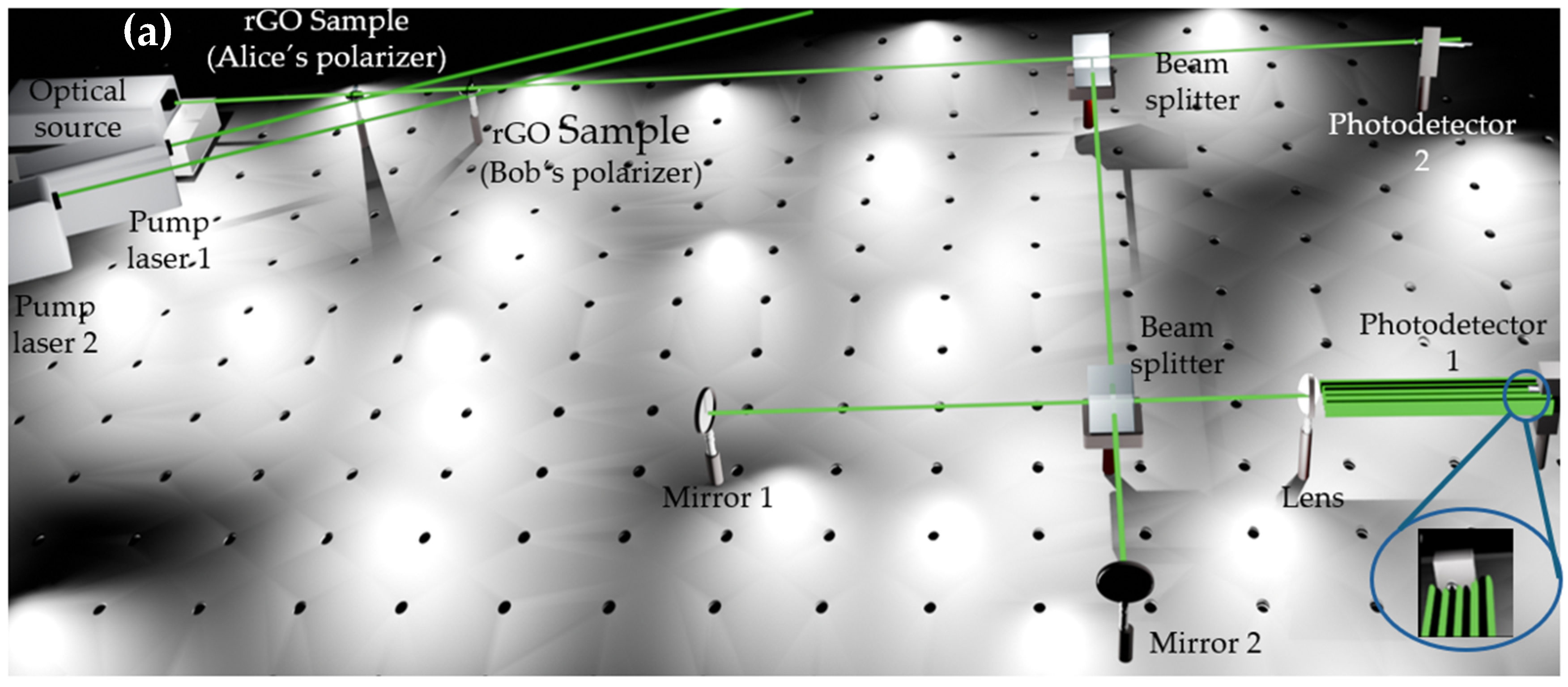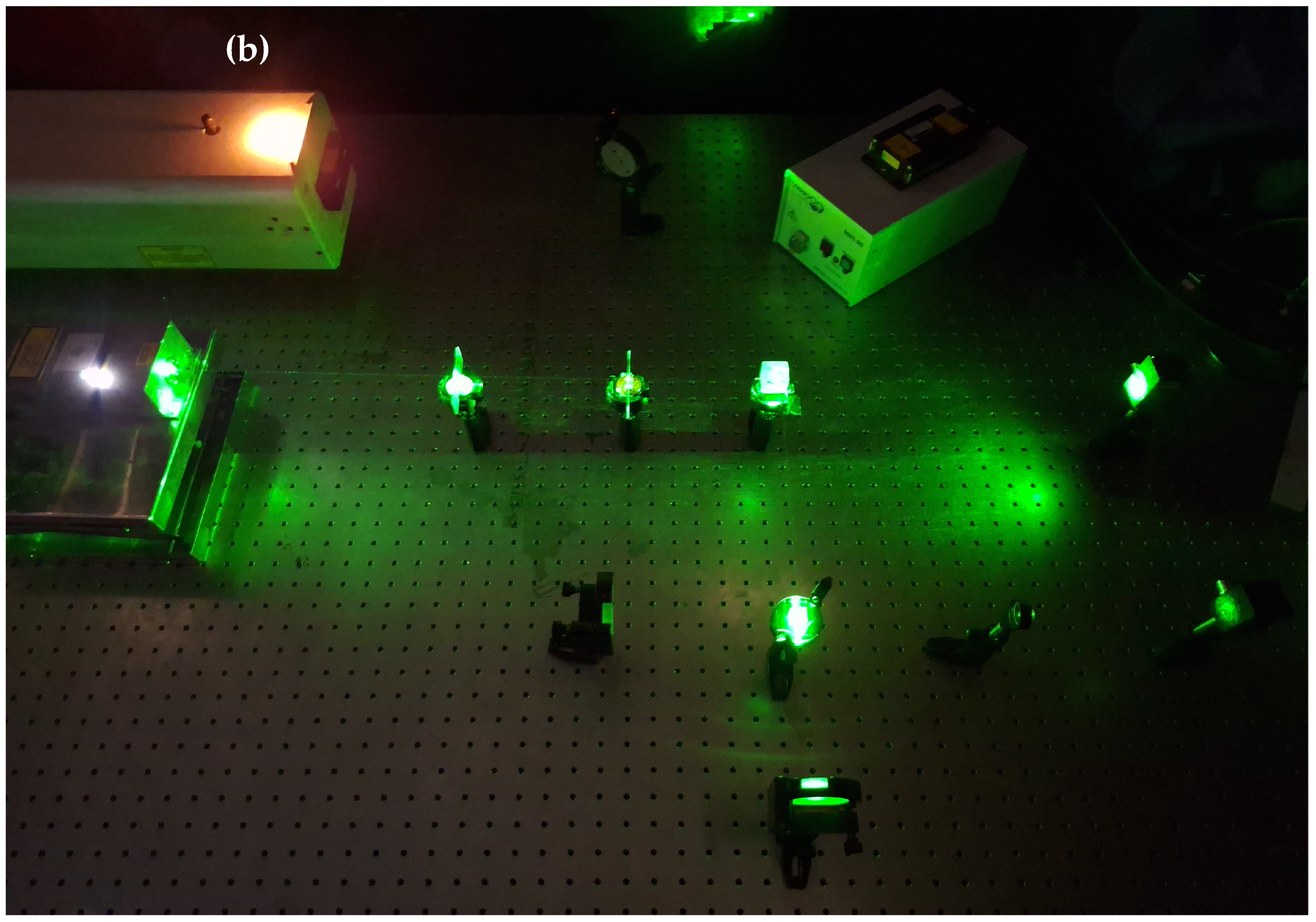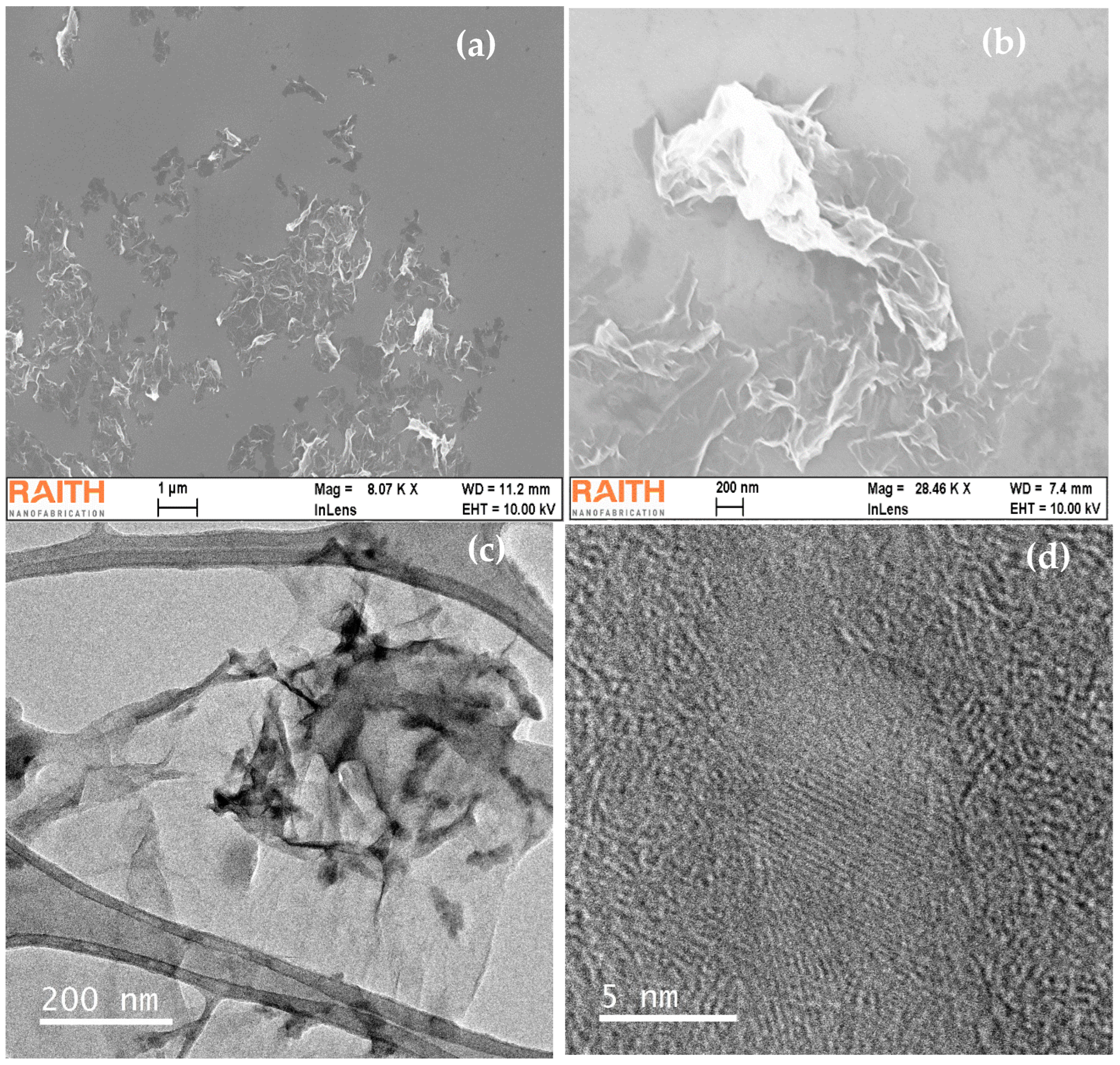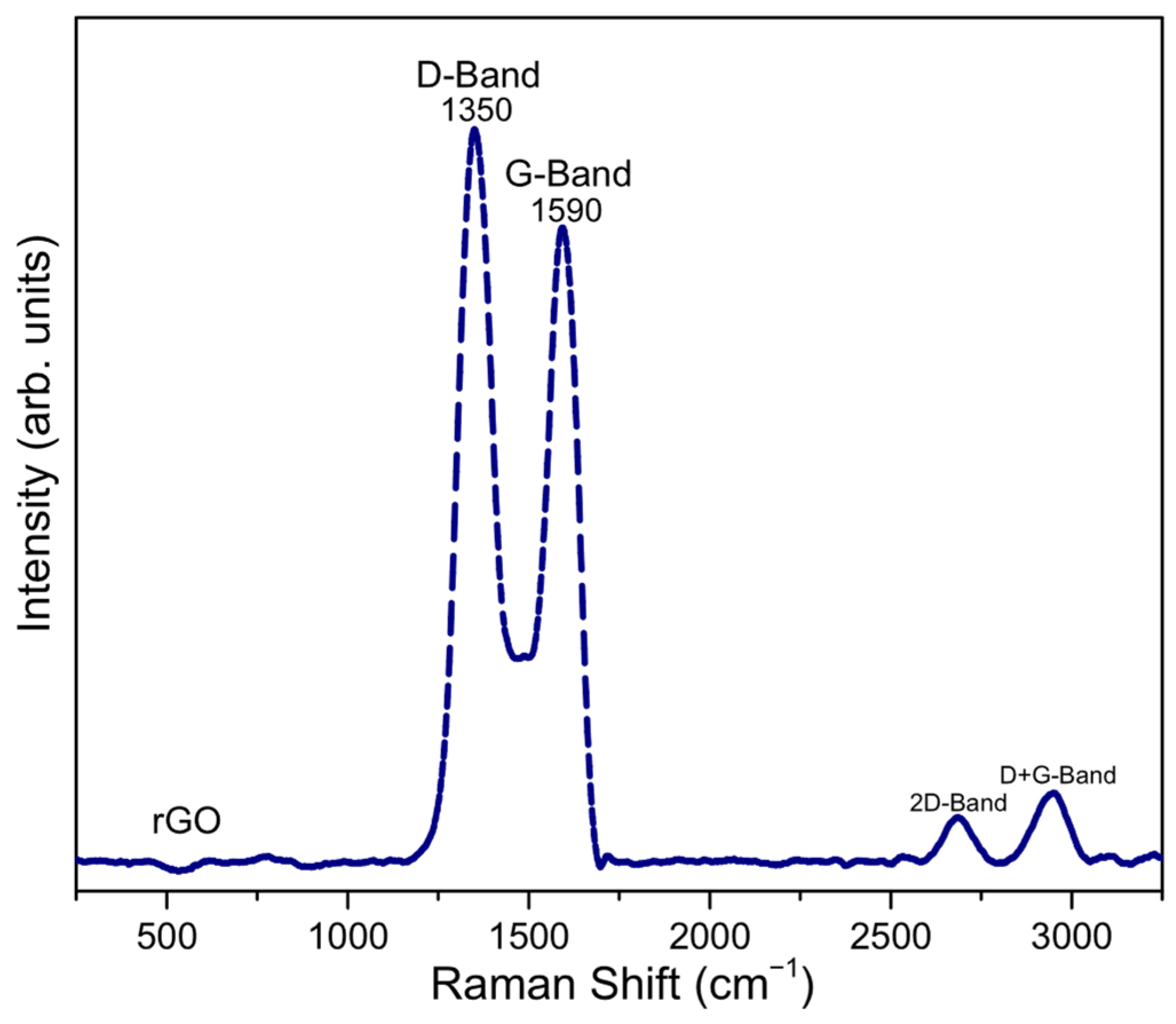Classical Encryption Demonstration with BB84 Quantum Protocol-Inspired Coherent States Using Reduced Graphene Oxide
Abstract
1. Introduction
2. Materials and Methods
2.1. Preparation and Deposition of rGO Using Langmuir–Blodgett Technique
2.2. Characterization of the Samples
2.3. Quantum Protocol BB84 Assisted by Coherence
3. Results and Discussions
3.1. Morphological: SEM and TEM Micrography
3.2. Raman Spectroscopy and X-Ray Diffraction Analysis
3.3. Encryption Protocol BB84 Assisted by Coherence
3.4. Temporal Resolution Requirements for Quantum Protocols
4. Conclusions
Supplementary Materials
Author Contributions
Funding
Data Availability Statement
Acknowledgments
Conflicts of Interest
References
- Menezes, A.J.; van Oorschot, P.C.; Vanstone, S.A. Handbook of Applied Cryptography; CRC Press: Boca Raton, FL, USA, 1996. [Google Scholar]
- Salmanpour, A.; Mohammadnejad, S.; Bahrami, A. All-optical photonic crystal AND, XOR, and OR logic gates using nonlinear Kerr effect and ring resonators. J. Mod. Opt. 2015, 62, 693–700. [Google Scholar] [CrossRef]
- Stinson, D.R. Cryptography: Theory and Practice; Chapman and Hall/CRC: Boca Raton, FL, USA, 2005. [Google Scholar]
- Gisin, N.; Ribordy, G.; Tittel, W.; Zbinden, H. Quantum cryptography. Rev. Mod. Phys. 2002, 74, 145–195. [Google Scholar] [CrossRef]
- Bennett, C.H.; Brassard, G. Quantum cryptography: Public key distribution and coin tossing. Theor. Comput. Sci. 2014, 560, 7–11. [Google Scholar] [CrossRef]
- Stankovich, S.; Dikin, D.A.; Dommett, G.H.B.; Kohlhaas, K.M.; Zimney, E.J.; Stach, E.A.; Piner, R.D.; Nguyen, S.T.; Ruoff, R.S. Graphene-based composite materials. Nature 2006, 442, 282–286. [Google Scholar] [CrossRef]
- Jaafar, E.; Kashif, M.; Sahari, S.K.; Ngaini, Z. Study on Morphological, Optical and Electrical Properties of Graphene Oxide (GO) and Reduced Graphene Oxide (rGO). Mater. Sci. Forum 2018, 917, 112–116. [Google Scholar] [CrossRef]
- Scully, M.O.; Zubairy, M.S. Quantum distribution theory and partially coherent radiation. In Quantum Optics; Cambridge University Press: Cambridge, UK, 1997; pp. 72–96. [Google Scholar]
- Feng, M.; Zhan, H.; Chen, Y. Nonlinear optical and optical limiting properties of graphene families. Appl. Phys. Lett. 2010, 96, 033107. [Google Scholar] [CrossRef]
- Hernández, A.A.R.; Morales, P.C.; Gujari, S.K.; Rocha, M.G.; Pérez, D.V. pH effect in Langmuir–Blodgett self-assembly of MoS2 and WS2 thin films. J. Mater. Sci. Mater. Electron. 2024, 35, 1326. [Google Scholar] [CrossRef]
- Shor, P.W.; Preskill, J. Simple Proof of Security of the BB84 Quantum Key Distribution Protocol. Phys. Rev. Lett. 2000, 85, 441–444. [Google Scholar] [CrossRef]
- Feldmann, J.; Youngblood, N.; Wright, C.D.; Bhaskaran, H.; Pernice, W.H.P. All-optical spiking neurosynaptic networks with self-learning capabilities. Nature 2019, 569, 208–214. [Google Scholar] [CrossRef]
- Steinbrecher, G.R.; Olson, J.P.; Englund, D.; Carolan, J. Quantum optical neural networks. npj Quantum Inf. 2019, 5, 60. [Google Scholar] [CrossRef]
- Killoran, N.; Bromley, T.R.; Arrazola, J.M.; Schuld, M.; Quesada, N.; Lloyd, S. Continuous-variable quantum neural networks. Phys. Rev. Res. 2019, 1, 033063. [Google Scholar] [CrossRef]
- Soriano, M.C.; Brunner, D.; Escalona-Morán, M.; Mirasso, C.R.; Fischer, I. Minimal approach to neuro-inspired information processing. Front. Comput. Neurosci. 2015, 9, 68. [Google Scholar] [CrossRef] [PubMed] [PubMed Central]
- Shastri, B.J.; Tait, A.N.; de Lima, T.F.; Pernice, W.H.P.; Bhaskaran, H.; Wright, C.D.; Prucnal, P.R. Photonics for artificial intelligence and neuromorphic computing. arXiv 2020, arXiv:2011.00111. [Google Scholar] [CrossRef]
- Buttler, W.T.; Hughes, R.J.; Kwiat, P.G.; Lamoreaux, S.K.; Luther, G.G.; Morgan, G.L.; Nordholt, J.E.; Peterson, C.G.; Simmons, C.M. Practical Free-Space Quantum Key Distribution over 1 km. Phys. Rev. Lett. 1998, 81, 3283–3286. [Google Scholar] [CrossRef]
- Chen, Y.A.; Zhang, Q.; Chen, T.Y.; Cai, W.Q.; Liao, S.K.; Zhang, J.; Chen, K.; Yin, J.; Ren, J.G.; Chen, Z.; et al. An integrated space-to-ground quantum communication network over 4600 kilometres. Nature. 2021, 589, 214–219. [Google Scholar] [CrossRef] [PubMed]
- King, A.A.K.; Davies, B.R.; Noorbehesht, N.; Newman, P.; Church, T.L.; Harris, A.T.; Razal, J.M.; Minett, A.I. A New Raman Metric for the Characterisation of Graphene oxide and its Derivatives. Sci. Rep. 2016, 6, 19491. [Google Scholar] [CrossRef]
- Claramunt, S.; Varea, A.; López-Díaz, D.; Velázquez, M.M.; Cornet, A.; Cirera, A. The Importance of Interbands on the Interpretation of the Raman Spectrum of Graphene Oxide. J. Phys. Chem. C 2015, 119, 10123–10129. [Google Scholar] [CrossRef]
- Lesiak, B.; Trykowski, G.; Tóth, J.; Biniak, S.; Kövér, L.; Rangam, N.; Stobinski, L.; Malolepszy, A. Chemical and structural properties of reduced graphene oxide—Dependence on the reducing agent. J. Mater. Sci. 2021, 56, 3738–3754. [Google Scholar] [CrossRef]
- Solís-Fernández, P.; Rozada, R.; Paredes, J.; Villar-Rodil, S.; Fernández-Merino, M.; Guardia, L.; Martínez-Alonso, A.; Tascón, J. Chemical and microscopic analysis of graphene prepared by different reduction degrees of graphene oxide. J. Alloys Compd. 2012, 536, S532–S537. [Google Scholar] [CrossRef]
- Khan, A.; Sapakal, S.N.; Kadam, A. Comparative analysis of graphene oxide (GO) reduction methods: Impact on crystallographic, morphological, and optical properties. Graphene 2D Mater. 2024, 9, 101–109. [Google Scholar] [CrossRef]
- Lo, H.K.; Curty, M.; Tamaki, K. Secure quantum key distribution. Nat. Photonics 2014, 8, 595–604. [Google Scholar] [CrossRef]
- Wang, J.; Sciarrino, F.; Laing, A.; Thompson, M.G. Integrated photonic quantum technologies. Nat. Photonics 2020, 14, 273–284. [Google Scholar] [CrossRef]
- Xu, F.; Ma, X.; Zhang, Q.; Lo, H.K.; Pan, J.W. Secure quantum key distribution with realistic devices. Rev. Mod. Phys. 2020, 92, 025002. [Google Scholar] [CrossRef]
- Diamanti, E.; Lo, H.-K.; Qi, B.; Yuan, Z. Practical challenges in quantum key distribution. npj Quantum Inf. 2016, 2, 16025. [Google Scholar] [CrossRef]
- Singh, P.; Tripathi, D.K.; Jaiswal, S.; Dixit, H.K. All-Optical Logic Gates: Designs, Classification, and Comparison. Adv. Opt. Technol. 2014, 2014, 28–40. [Google Scholar] [CrossRef]
- Liu, Z.; Zhang, X.; Yan, X.; Chen, Y.; Tian, J. Nonlinear optical properties of graphene-based materials. Chin. Sci. Bull. 2012, 57, 2971–2982. [Google Scholar] [CrossRef]
- Liu, M.; Yin, X.; Ulin-Avila, E.; Geng, B.; Zentgraf, T.; Ju, L.; Wang, F.; Zhang, X. A graphene-based broadband optical modulator. Nature 2011, 474, 64–67. [Google Scholar] [CrossRef]
- Zhang, H.; Virally, S.; Bao, Q.; Ping, L.K.; Massar, S.; Godbout, N.; Kockaert, P. Z-scan measurement of the nonlinear refractive index of graphene. Opt. Lett. 2012, 37, 1856–1858. [Google Scholar] [CrossRef]
- Hendry, E.; Hale, P.J.; Moger, J.; Savchenko, A.K.; Mikhailov, S.A. Coherent nonlinear optical response of graphene. Phys. Rev. Lett. 2010, 105, 097401. [Google Scholar] [CrossRef]
- Wang, F.; Zhang, Y.; Tian, C.; Girit, C.; Zettl, A.; Crommie, M.; Shen, Y.R. Gate-variable optical transitions in graphene. Science 2008, 320, 206–209. [Google Scholar] [CrossRef]
- Sibson, P.; Erven, C.; Godfrey, M.; Miki, S.; Yamashita, T.; Fujiwara, M.; Sasaki, M.; Terai, H.; Tanner, M.G.; Natarajan, C.M.; et al. Chip-based quantum key distribution. Nat. Commun. 2017, 8, 13984. [Google Scholar] [CrossRef]
- Kues, M.; Reimer, C.; Roztocki, P.; Cortés, L.R.; Sciara, S.; Wetzel, B.; Zhang, Y.; Cino, A.; Chu, S.T.; Little, B.E.; et al. On-chip generation of high-dimensional entangled quantum states and their coherent control. Nature 2017, 546, 622–626. [Google Scholar] [CrossRef] [PubMed]
- Sousa, J.R.R.; Filho, A.F.G.F.; Ferreira, A.C.; Figueirêdo, E.R.B.; Sales, J.C.; Costa, M.B.C.; Guimarães, G.F.; Sombra, A.S.B. All-optical or logic gate based on a photonic crystal fiber Michelson interferometer operating with pulse-position modulation. Opt. Eng. 2019, 58, 056101. [Google Scholar] [CrossRef]
- Abid; Sehrawat, P.; Islam, S.S.; Mishra, P.; Ahmad, S. Reduced graphene oxide (rGO) based wideband optical sensor and the role of Temperature, Defect States and Quantum Efficiency. Sci. Rep. 2018, 8, 3537. [Google Scholar] [CrossRef] [PubMed]
- Ekert, A.K. Quantum cryptography based on Bell’s theorem. Phys. Rev. Lett. 1991, 67, 661–663. [Google Scholar] [CrossRef]
- Pirandola, S.; Andersen, U.L.; Banchi, L.; Berta, M.; Bunandar, D.; Colbeck, R.; Englund, D.; Gehring, T.; Lupo, C.; Ottaviani, C.; et al. Advances in quantum cryptography. Adv. Opt. Photonics 2020, 12, 1012–1236. [Google Scholar] [CrossRef]
- Eisaman, M.D.; Fan, J.; Migdall, A.; Polyakov, S.V. Single-photon sources and detectors. Rev. Sci. Instrum. 2011, 82, 071101. [Google Scholar] [CrossRef]
- Phare, C.T.; Lee, Y.H.D.; Cardenas, J.; Lipson, M. Graphene electro-optic modulator with 30 GHz bandwidth. Nat. Photonics 2015, 9, 511–514. [Google Scholar] [CrossRef]
- Abellan, C.; Amaya, W.; Jofre, M.; Curty, M.; Acín, A.; Capmany, J.; Pruneri, V.; Mitchell, M.W. Ultra-fast quantum randomness generation by accelerated phase diffusion in a pulsed laser diode. Opt. Express 2014, 22, 1645–1654. [Google Scholar] [CrossRef]
- Mikhailov, S.A. Non-linear electromagnetic response of graphene. Europhys. Lett. 2007, 79, 27002. [Google Scholar] [CrossRef]
- Pugh, C.J.; Kaiser, S.; Bourgoin, J.P.; Jin, J.; Sultana, N.; Agne, S.; Anisimova, E.; Makarov, V.; Choi, E.; Higgins, B.L.; et al. Airborne demonstration of a quantum key distribution receiver payload. Quantum Sci. Technol. 2017, 2, 024009. [Google Scholar] [CrossRef]
- Riley, W.J. Handbook of frequency stability analysis. NIST Spec. Publ. 2008, 1065, 31–45. [Google Scholar]
- Buller, G.S.; Collins, R.J. Single-photon generation and detection. Meas. Sci. Technol. 2010, 21, 012002. [Google Scholar] [CrossRef]
- Boyd, R.W. Nonlinear Optics; Academic Press: Cambridge, MA, USA, 1992. [Google Scholar]
- Scarani, V.; Bechmann-Pasquinucci, H.; Cerf, N.J.; Dušek, M.; Lütkenhaus, N.; Peev, M. The security of practical quantum key distribution. Rev. Mod. Phys. 2009, 81, 1301–1350. [Google Scholar] [CrossRef]
- Lütkenhaus, N. Security against individual attacks for realistic quantum key distribution. Phys. Rev. A 2000, 61, 052304. [Google Scholar] [CrossRef]
- Buttler, W.T.; Lamoreaux, S.K.; Torgerson, J.R.; Nickel, G.H.; Donahue, C.H.; Peterson, C.G. Fast, efficient error reconciliation for quantum cryptography. Phys. Rev. A 2003, 67, 052303. [Google Scholar] [CrossRef]
- Stucki, D.; Walenta, N.; Vannel, F.; Thew, R.T.; Gisin, N.; Zbinden, H.; Gray, S.; Towery, C.R.; Ten, S. High rate, long-distance quantum key distribution over 250 km of ultra low loss fibres. New J. Phys. 2009, 11, 075003. [Google Scholar] [CrossRef]
- Renner, R. Security of quantum key distribution. Int. J. Quantum Inf. 2008, 6, 1–127. [Google Scholar] [CrossRef]
- Tanaka, A.; Fujiwara, M.; Nam, S.W.; Nambu, Y.; Takahashi, S.; Maeda, W.; Yoshino, K.-I.; Miki, S.; Baek, B.; Wang, Z.; et al. Ultra fast quantum key distribution over a 97 km installed telecom fiber with wavelength division multiplexing clock synchronization. Opt. Express 2008, 16, 11354–11360. [Google Scholar] [CrossRef]
- Zhang, Q.; Xu, F.; Chen, Y.A.; Peng, C.Z.; Pan, J.W. Large scale quantum key distribution: Challenges and solutions. Opt. Express 2018, 26, 24260–24273. [Google Scholar] [CrossRef]
- Korzh, B.; Lim, C.C.W.; Houlmann, R.; Gisin, N.; Li, M.J.; Nolan, D.; Sanguinetti, B.; Thew, R.; Zbinden, H. Provably secure and practical quantum key distribution over 307 km of optical fibre. Nat. Photonics 2015, 9, 163–168. [Google Scholar] [CrossRef]
- Hughes, R.J.; Nordholt, J.E.; Derkacs, D.; Peterson, C.G. Practical free-space quantum key distribution over 10 km in daylight and at night. New J. Phys. 2002, 4, 43. [Google Scholar] [CrossRef]
- Xavier, G.B.; de Faria, G.V.; Temporao, G.P.; von der Weid, J.P. Full polarization control for fiber optical quantum communication systems using polarization encoding. Opt. Express 2008, 16, 1867–1873. [Google Scholar] [CrossRef] [PubMed]
- Bao, Q.; Zhang, H.; Wang, Y.; Ni, Z.; Yan, Y.; Shen, Z.X.; Loh, K.P.; Tang, D.Y. Atomic-Layer Graphene as a Saturable Absorber for Ultrafast Pulsed Lasers. Adv. Funct. Mater. 2009, 19, 3077–3083. [Google Scholar] [CrossRef]
- Sun, Z.; Hasan, T.; Torrisi, F.; Popa, D.; Privitera, G.; Wang, F.; Bonaccorso, F.; Basko, D.M.; Ferrari, A.C. Graphene mode-locked ultrafast laser. ACS Nano 2010, 4, 803–810. [Google Scholar] [CrossRef] [PubMed]
- Takesue, H.; Nam, S.W.; Zhang, Q.; Hadfield, R.H.; Honjo, T.; Tamaki, K.; Yamamoto, Y. Quantum key distribution over a 40-dB channel loss using superconducting single-photon detectors. Nat. Photonics 2007, 1, 343–348. [Google Scholar] [CrossRef]





| Bit Value | Rectilinear Basis (+) | Diagonal Basis (×) |
|---|---|---|
| 0 | Vertical  | Diagonal  |
| 1 | Horizontal  | Anti-diagonal  |
| Input Polarization | Input Qubit | Polarization Basis (Random) | Results | Read Qubit | Ratio of Coincidence |
|---|---|---|---|---|---|
 | 0Q | + |  100% 100% | 0Q 100% | 100% |
 | 0Q | × |  50% 50%  50% 50% | 0Q 50% 1Q 50% | 50% |
 | 1Q | + |  100% 100% | 1Q 100% | 100% |
 | 1Q | × |  50% 50% 50% 50% | 0Q 50% 1Q 50% | 50% |
 | 0Q | + |  50% 50%  50% 50% | 0Q 50% 1Q 50% | 50% |
 | 0Q | × |  100% 100% | 0Q 100% | 100% |
 | 1Q | + |  50% 50%  50% 50% | 0Q 50% 1Q 50% | 50% |
 | 1Q | × |  100% 100% | 1Q 100% | 100% |
| Photon Order | 1 | 2 | 3 | 4 | 5 | 6 | 7 | 8 | 9 | 10 |
|---|---|---|---|---|---|---|---|---|---|---|
| Alice Polarization basis (random) | × | + | + | + | × | × | + | × | + | × |
| Sender results |
 |
 |
 |
 |
 |
 |
 |
 |
 |
 |
| Sent qubits | 0Q | 0Q | 1Q | 1Q | 1Q | 0Q | 0Q | 0Q | 0Q | 1Q |
| Bob polarization basis (random) | × | × | + | + | + | × | × | × | + | + |
| Read qubits | 0Q | 0Q or 1Q | 1Q | 1Q | 0Q or 1Q | 0Q | 0Q or 1Q | 0Q | 0Q | 0Q or 1Q |
| Ratio of coincidence | 100% | 50% | 100% | 100% | 50% | 100% | 50% | 100% | 100% | 50% |
| Key Bits | 0 | - | 1 | 1 | - | 0 | - | 0 | 0 | - |
| Measured Power (mW) | 0.25 | 2.30 | 4.50 | 4.85 | 2.60 | 0.35 | 2.70 | 0.40 | 0.20 | 2.15 |
Disclaimer/Publisher’s Note: The statements, opinions and data contained in all publications are solely those of the individual author(s) and contributor(s) and not of MDPI and/or the editor(s). MDPI and/or the editor(s) disclaim responsibility for any injury to people or property resulting from any ideas, methods, instructions or products referred to in the content. |
© 2025 by the authors. Licensee MDPI, Basel, Switzerland. This article is an open access article distributed under the terms and conditions of the Creative Commons Attribution (CC BY) license (https://creativecommons.org/licenses/by/4.0/).
Share and Cite
Lopez-Bastida, A.; Córdova-Morales, P.; Valdez-Pérez, D.; Martinez-Rivas, A.; de la Rosa-Vázquez, J.M.; Torres-Torres, C. Classical Encryption Demonstration with BB84 Quantum Protocol-Inspired Coherent States Using Reduced Graphene Oxide. Quantum Rep. 2025, 7, 35. https://doi.org/10.3390/quantum7030035
Lopez-Bastida A, Córdova-Morales P, Valdez-Pérez D, Martinez-Rivas A, de la Rosa-Vázquez JM, Torres-Torres C. Classical Encryption Demonstration with BB84 Quantum Protocol-Inspired Coherent States Using Reduced Graphene Oxide. Quantum Reports. 2025; 7(3):35. https://doi.org/10.3390/quantum7030035
Chicago/Turabian StyleLopez-Bastida, Alexia, Pablo Córdova-Morales, Donato Valdez-Pérez, Adrian Martinez-Rivas, José M. de la Rosa-Vázquez, and Carlos Torres-Torres. 2025. "Classical Encryption Demonstration with BB84 Quantum Protocol-Inspired Coherent States Using Reduced Graphene Oxide" Quantum Reports 7, no. 3: 35. https://doi.org/10.3390/quantum7030035
APA StyleLopez-Bastida, A., Córdova-Morales, P., Valdez-Pérez, D., Martinez-Rivas, A., de la Rosa-Vázquez, J. M., & Torres-Torres, C. (2025). Classical Encryption Demonstration with BB84 Quantum Protocol-Inspired Coherent States Using Reduced Graphene Oxide. Quantum Reports, 7(3), 35. https://doi.org/10.3390/quantum7030035








